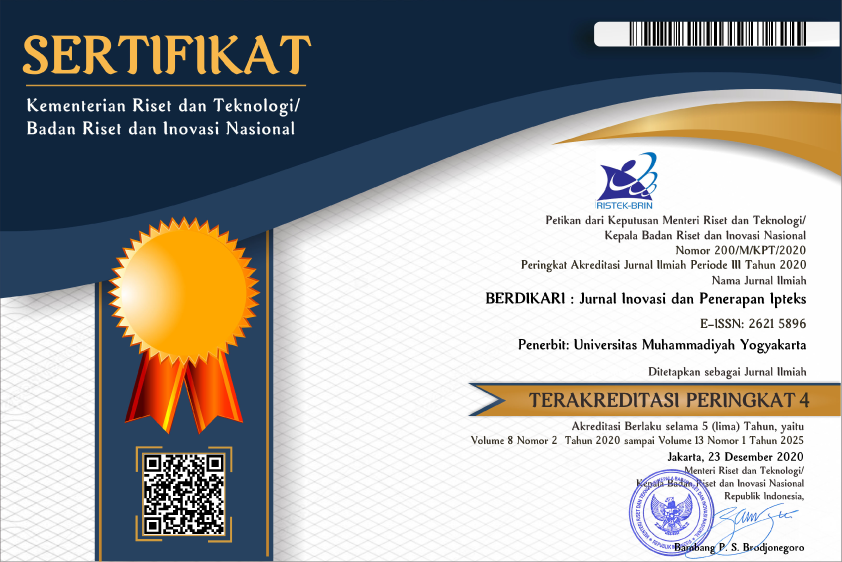Pemeriksaan dan Edukasi Gangguan Pendengaran Pada Anak Panti Asuhan
DOI:
https://doi.org/10.18196/berdikari.v11i1.16639Keywords:
ear, hearing, cerumen, orphanageAbstract
Unhealthy ears may cause hearing loss. This issue may affect children to have difficulty communicating with others and decrease learning achievement at school. This community service activity aimed to give knowledge about hearing loss and conduct hearing examinations in orphanage children. This community service was held at the Aulia Al-Ikhlas Orphanage in Sungai Pagar Village, Kampar Kiri Hilir District, Kampar Regency, Riau. At the beginning of the activity, we provided counseling about hearing loss, followed by ear and hearing examinations using a tuning fork. Before and after the counseling, respondents filled out a questionnaire to assess knowledge about hearing loss. Twenty-four residents of the orphanage attended this activity. The questionnaires found that children's knowledge about hearing loss and ear health increased significantly after the counseling. The examination results found cerumen in 14 children, 4 with conductive hearing loss and 2 with sensory neural hearing loss. As a result, this community service activity can increase the knowledge of orphanage children about hearing loss and make their ears cleaner and healthier.
References
ASHA. (2018). Hearing loss. https://www.asha.org/public/hearing/Hearing-Loss/
Hamzah NF, Tajuddin A. (2021). The Effect of Earphone Use Behavior on Ear Disorders in Students University of Muhammadiyah Makassar, 2020. Al-Iqra Medical Journal, 17.
Kementerian Kesehatan Republik Indonesia. (2010). Telinga sehat pendengaran baik. https://www.kemkes.go.id/article/view/840/telinga-sehat-pendengaran-baik.html
Kementrian Kesehatan Republik Indonesia. (2016). Direkorat Jenderal Penyakit Tidak Menular. Profil Penyakit Tidak Menular.
http://p2ptm.kemkes.go.id/dokumen-ptm/profil-penyakit-tidak-menular-tahun-2016
Kolegium Ilmu Kesehatan THT. Modul THT Komunitas. Gangguan Pendengaran pada Anak Usia Sekolah. Edisi 1. Jakarta: Kolegium Ilmu Kesehatan THT-KL;2008.
Laoh A, Rumampuk JF, Lintong F. (2015). Hubungan penggunaan headset terhadap fungsi pendengaran pada mahasiswa angkatan 2012 Fakultas Kedokteran Universitas Sam Ratulangi. Jurnal Kedokteran Komunitas dan Tropik;3(3):142-147.
Martini, E., Probandari, A., Pratiwi, D., & Sumardiyono. (2017). Skrining dan Edukasi Gangguan Pendengaran pada Anak Sekolah. Indonesian Journal On Medical Science, 4(1), 110–118. https://ejournal.ijmsbm.org/index.php/ijms/article/view/103
Novita I, Rahayu MS. (2015). Hubungan perilaku penggunaan alat dengar telinga dengan gangguan pendengaran pada mahasiswa program studi pendidikan dokter. Lentera;15(13):23-28.
Soetirto I, Hendarmin H, Bashiruddin J. (2012). Gangguan Pendengaran (Tuli). Dalam: Soepardi EA, Iskandar N, Bashiruddin J, Restuti RD (Eds.), Buku Ajar Ilmu Kesehatan Telinga Hidung Tenggorok Kepala & Leher. Edisi ketujuh. Jakarta: Fakultas Kedokteran Universitas Indonesia.
Susiyanti E, Imanto M. Efek penggunaan earphone sebagai faktor resiko kejadian noise induced hearing loss. Majority 2020;9(2):63-67.
WHO. (2021). World Report on Hearing. In World Health Organization. https://www.who.int/publications/i/item/world-report-on-hearing
Downloads
Published
Issue
Section
License
Copyright
Authors retain copyright and grant BERDIKARI Jurnal Inovasi dan Penerapan IPTEK the right of first publication with the work simultaneously licensed under an Attribution 4.0 International (CC BY 4.0) that allows others to remix, adapt and build upon the work with an acknowledgment of the work's authorship and of the initial publication in BERDIKARI Jurnal Inovasi dan Penerapan IPTEK.
Authors are permitted to copy and redistribute the journal's published version of the work (e.g., post it to an institutional repository or publish it in a book), with an acknowledgment of its initial publication in BERDIKARI Jurnal Inovasi dan Penerapan IPTEK
License
Articles published in the BERDIKARI Jurnal Inovasi dan Penerapan IPTEK) are licensed under an Attribution 4.0 International (CC BY 4.0) license. You are free to:
- Share — copy and redistribute the material in any medium or format.
- Adapt — remix, transform, and build upon the material for any purpose, even commercially.
This license is acceptable for Free Cultural Works. The licensor cannot revoke these freedoms as long as you follow the license terms. Under the following terms:
- Attribution — You must give appropriate credit, provide a link to the license, and indicate if changes were made. You may do so in any reasonable manner, but not in any way that suggests the licensor endorses you or your use.
- No additional restrictions — You may not apply legal terms or technological measures that legally restrict others from doing anything the license permits.




